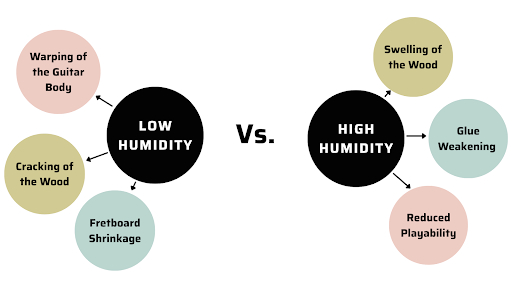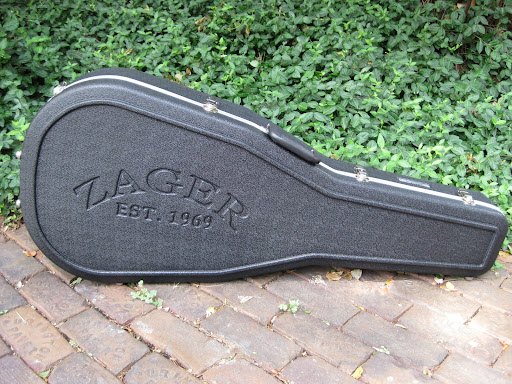Guitar Humidity: What’s the Ideal Humidity for Guitars?

The time has arrived— to keep the surrounding humidity in check.
Because that can pose big problems to your string friends.
Yes. Guitar humidity is actually a thing. It talks about what level of moisture content is healthy for the instrument and which range can wreck it.
- High humidity means– wood takes on a lot of water from the air. The material becomes flexible causing it to swell.
- Low humidity means– the wood loses moisture to the air. The fiber contracts and becomes too rigid causing it to develop cracks.
| So, what’s the ideal humidity for guitars? It’s 40% to 60%. |
That’s not it. You must know how to maintain the right humidity and care for your guitar too.
Let’s give extra love to your guitar today and know– why you should control the moisture content.
Know about Different Types Of Acoustic Guitars.
Ideal Humidity Range
A guitar stays the healthiest when it’s under the 40%-60% humidity range.
That’s what most guitar manufacturers and experts recommend. In fact! Both Martin and Taylor suggest this RH.
Why? It keeps the wood stable.
As we all know, wood makes up most of your guitar. So, it’s your responsibility to ensure its safety.
A bit of high or low is okay. But if the humidity is off, your guitar can warp.
Why is This Range Important?
You can call the 40-60% range “the sweet spot”. It’s because– there’s wood stability.
Being a primary material, tonewood tends to be hygroscopic. Such material adsorbs or desorbs water depending on 3 variables–
- Temperature
- Relative humidity
- Surrounding environment
The wood maintains its shape within the 40-60% RH range as it naturally adjusts its moisture content to the air around it. This represents Equilibrium Moisture Content.
In that range— the moisture gain or loss rate is minimal. So, EMC works to keep the wood stable and prevent distortion.
Problems occur when climate changes and levels up or down moisture in the air. As it goes out of range, tonewood fails to maintain the moisture or shape. Consequently, the guitar undergoes different issues.
Impact of Climate on Guitar Maintenance
Climates, dry or humid, have a massive impact on guitar upkeep. They manage to alter the physical and chemical properties of the guitar, particularly wood.
Dry climates
This means low humidity. In areas like deserts, the air can dry out your wood.
This triggers the guitar to shrink which can result in cracks or splits.
Some areas having dry climates are—
- North Africa
- Middle East
- North America
- Northern Canada
- Greenland
- Siberia
Humid Climates
It represents low humidity. Tropical regions are mostly known as humid areas. There, the air has excess moisture that can cause the tonewood to swell.
Such expansion can damage the glue that holds all guitar components together.
Some areas having wet climates are—
- South America
- Central Africa
- Oceania
- Pacific Northwest
- Thailand
- Malaysia
Risks of Improper Humidity Levels

Low Humidity Effects
Once the humidity drops below 40%, the guitar can face different issues—
Warping of the Guitar Body
Low humidity can dry out the wood and cause the guitar to warp.
A warped body affects the tone of your guitar. It starts giving you a very distinctive dry tone.
The tone might sound brighter and sharper but also thin and metallic. You notice a big loss of depth. Plus, there’s little to no coloration.
In the bass frequencies, you get less resonant sounds.
The dryness also brings playability problems. There might be sharp fret ends or buzzing above the 6th fret.
All these issues related to tone and functions because of shrinkage make the guitar uncomfortable to play.
Cracking of the Wood
Losing a lot of moisture can crack your guitar, especially the wood.
Cracks can appear on any part of the guitar. Often it’s on the body, neck, and fretboard.
The issue is repairing cracks on such parts can be challenging.
Such splits also affect the sound. They can hinder sound vibrations traveling across the top. This leads to weird tonal changes.
This mostly occurs on acoustic.
Fretboard Shrinkage
Moisture loss in the wood hurts the fretboard the most. The fretboard shrinks whereas the frets become uneven.
Plus, the rugged frets make them stick out from the neck.
This makes your guitar super uncomfortable to play. It also can lead to injury if the frets are sharp.
High Humidity Effects
When humidity levels go beyond 60%, the guitar might run into distinctive issues–
Swelling of the Wood
Absorbing excess moisture enables the guitar to swell. This changes the entire shape of your instrument, especially areas below the bridge. It grows big and affects the string’s tension and tone.
A swollen body mainly causes high-string action. If you’re used to such mechanisms, it’ll be super hard for you to strum.
The tonal characteristics change too. It lowers the clarity. The guitar may sound softer but more like bass-heavy.
Glue Weakening
Many guitar parts are held together with glue. You can take Gibson models for instance.
The manufacturers might use strong adhesives like:
- Titebond hide glue or
- The basic ‘Elmer’s yellow
Too much moisture can weaken the glue that holds the bridge no matter how strong it is. As the glue becomes softer, the guitar parts fall apart.
This makes the guitar almost impossible to play. Make sure to look for signs of glue weakening like–
- Visible gaps or splits
- Buzzing sound
- Loose parts
- High string action
Take steps before it’s too late.
Reduced Playability
High moisture content in the guitar makes the guitar extremely hard to strum.
A lot of changes take place besides a swollen body as mentioned–
- Higher string action
- Warped neck
- Uneven string tension
- Buzzing and mutings of strings
- Expanded fretboard
- Misaligned bridge
- Sticky-like finish on the neck and fretboard
All these can significantly affect your performance, especially in live settings.
Tools and Tips for Maintaining Proper Humidity

Humidity Upkeep Tools
Soundhole Humidifiers
Want something convenient? Get soundhole humidifiers.
They hang safely inside the soundhole, suspended by the guitar strings, so it doesn’t touch the body.
These tools help maintain the proper humidity level directly inside the body. A distinctive feature is they release the moisture slowly and evenly. This effectively helps keep your guitar perfectly humidified.
Some good options are—
- Zager Airtight Neoprene guitar humidification system
- Oasis humidifiers
- D’Addario Acoustic Guitar Humidifier
- Music Nomad soundhole humidifier
Check Out Our Specialized Guide On Humidity Hacks: How To Humidify A Guitar?
Guitar Cases with Humidity Control
Such cases are the king of all. Call them versatile because they house your guitar and maintain its moisture level.
These guitar cases are designed with built-in hygrometers humidifiers or both.
The bonus features give your guitar an extra protection layer. They ensure your instrument stays in a controlled but optimum environment.
Some good options include:
- Zager Pro ABS Ultra Light Molded Case w/ Digital Humidity System
- Guild Dreadnought (D) Deluxe Humidified
- The ShowCase Deluxe Guitar Display Case
- Gator Cases Deluxe ABS Molded Case
- D’Addario Humidipak
All of these work to monitor or maintain the humidity of your guitar while keeping it stored and protected.
Just check the size and other technical factors. Make sure to get one that can fit your guitar well.
Hygrometers
A guitar hygrometer monitors and measures the moisture content the air has. It helps you keep track of humidity levels, especially in the room where you keep your guitar.
Such tools are a small investment. But they can save you from major repair expenses.
Some good hygrometers include–
- Music Nomad “Humireader”
- ThermoPro TP50 Digital Hygrometer
- Oasis OH-2 Digital Hygrometer
- Inkbird ITH-10 Humidity Monitor
- ThermoPro TP50 Digital Hygrometer
They are quite reliable. The products provide accurate readings. Plus, they are easy to use.
Keep them in the room where the guitar is stored. That’s it. The tool will be there to monitor moisture levels. That way, you can take action if the humidity rate ever goes out of optimal range.
In-Case Humidifiers
You keep in-case devices right in the guitar case. They work like the cases with humidity control. The difference is you have to buy the device separately.
These humidifiers can regulate moisture content within the enclosed space. That’s the specialty.
Some effective In-Case Humidifiers are:
- Arion In-Case Humidifier
- Planet Waves Acoustic Guitar Humidifier
- Herco Guardfather
The devices look compact and small. So, they’ll be easier to fit.
Room Humidifiers
Have multiple guitars? Then room humidifiers are the apt options.
They’ll keep the entire room at an ideal humidity level. The devices will make sure all the guitars stay within EMC altogether!
Consider the following options if you want to buy:
- Levoit LV600HH Hybrid Ultrasonic Humidifier
- Vornado Evap40 Humidifier
- Honeywell Cool Mist Humidifier
Dehumidifiers
High humidity? Then get a dehumidifier.
Such devices work to reduce moisture content. They ensure the guitar’s moisture level doesn’t go extremely high and cause swelling.
Many models come compact. So, they’ll be easy to carry and store inside the case.
Try out options like:
- Eva-Dry E-333 Renewable Mini Dehumidifier
- Gocheer Upgraded Air Dehumidifier
- Honeywell 30-Pint Smart Energy Star Dehumidifier
Practical Tips
Room Setup
We suggest you keep the guitar in a different room– somewhere you can control the environment. Here, temperature and humidity are the main factors.
Keep it in a room or closet where you can control temperature and humidity.
Avoid placing it in spots where both can fluctuate. For instance—
- Windows, Doors, and Air vents
- A controlled setup helps maintain temperature and moisture consistency, especially under extreme climates.
Note that the ideal temperature for guitar storage is around 66 to 77°F.
Seasonal Adjustments
Humidity levels change with the seasons.
So, you must take measures to adjust the levels accordingly.
If it’s winter out there— the air can be super dry because of heating systems. For this, you have to use a humidifier to adjust the humidity.
If it’s summer— the air might take on excess moisture from evaporation. So, you’ll need a dehumidifier to lower the excess content.
To adjust the humidity correctly, use a hygrometer. Check the readings and then adjust accordingly.
Avoid Extreme Environments
Keep the guitar protected from extreme climates and elements like dust and rain.
Use a solid case for that.
If you want maximum protection, pick a hard case. Target the ones made of hardshell materials such as—
- Wood
- Fiberglass
- Injection molding
Moreover, never leave your guitar in a car, attic, or basement. Both temperature and humidity can fluctuate there dramatically.
Such environments can cause rapid moisture loss or gain. And this can result in serious damage.
Specialized Advice for Different Guitar Types
Let’s highlight some guitar maintenance tips.
Acoustic Guitars
Proper Humidity Range: Maintain RH between 45% and 55%.
Storage: Opt for the hardshell for acoustic.
Monitoring: Monitor them at least once a week for acoustic.
Upkeep: Use fretboard oil and rub it gently on the acoustic guitar with a cloth to condition the wood.
Electric Guitars
Proper Humidity Range: Keep it between 40% and 60%.
Storage: Have a hardshell or molded plastic case for electric models.
Monitoring: Monitor them at least twice a week or once a month.
Upkeep: Treat unsealed wooden components, especially on the neck, with mineral oil. This helps reduce humidity loss and prevent shrinkage.
Classical Guitars
Proper Humidity Range: Keep it around 50%.
Storage: Consider a hardshell case or a humidified case. Use the ones specifically designed for classical models.
Monitoring: Monitor at least twice a week.
Upkeep: Use a suitable wood conditioner or mineral oil.
Frequently Asked Questions
Keep it around 50%. Mr. Zager suggests that— ‘40-60%’ is the ideal relative humidity range.
Low humidity dries and cracks the wood. High humidity expands the shape and weakens the glue. That’s how humidity affects the physical traits of your guitar’s wood.
A hygrometer precisely monitors the humidity range. Guitar humidifiers and humidity-controlled cases are also highly recommended.
Absolutely. High humidity levels cause the wood of your guitar to swell. The glue weakens and you face structural damage.
Use tools like— hygrometers and humidifiers. Consider proper storage methods as well. This way, you can prevent humidity-related issues.
Manage The Right Humidity For Your Guitar’s Health
The best thing to do is to stay on average, i.e. around 50%. Such a humidity range will suit most guitar types.
Make sure to keep the guitar in a cool, dry place. Don’t leave it in places where the humidity can fluctuate.
Try to monitor the moisture content at least once a month. Any kind of carelessness that puts your guitar under strange humid behaviors— and can cause serious damage.
